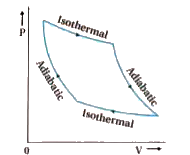Draw P-V curves for isothermal and adiabatic processes of an ideal gas.Solution in Gujrati
Figure shows the P→ V curves of an ideal gas for two adiabatic processes connecting two isotherms.

Topper's Solved these Questions
- BOOK - KUMAR PRAKASHANCHAPTER - THERMODYANMICS EXERCISE - Section-A (Try Your self )90videos
THERMODYANMICS
- BOOK - KUMAR PRAKASHANCHAPTER - THERMODYANMICS EXERCISE - Section-B Numericals (Numerical From Textual Exercise)10videos
THERMODYANMICS
- BOOK - KUMAR PRAKASHANCHAPTER - THERMAL PROPERTIES OF MATTEREXERCISE - Question Paper (Section - D) (Answer following in brief :) Each carry 4 marks1videos
THERMAL PROPERTIES OF MATTER
- BOOK - KUMAR PRAKASHANCHAPTER - UNITS AND MEASUREMENTEXERCISE - Section -F (Questions from Module )20videos
UNITS AND MEASUREMENT
Similar Questions
Which form of heat believed in before the modern time ?
01:36View SolutionA geyser heats water flowing at the rate of 3.0 litres per minute from 27∘ C to 77∘C. If the geyser operates on a gas burner, what is the rate of consumption of the fuel if its heat of combustion is 4.0×104 J/g ?
03:19View SolutionIn an experiment on the specific heat of a metal, a 0.20 kg block of the metal at 150∘C is dropped in a copper calorimeter (of water equivalent 0.025 kg) containing 150 cm3 of water at 27∘C. The final temperature is 40∘C. Compute the specific heat of the metal. If heat losses to the surroundings are not negligible, is your answer greater or smaller than the actual value for specific heat of the metal ?
05:27View SolutionIf the error in measurement of radius of a shpere is 2% then the error in determination of volume of the sphere will be …………
01:28View SolutionCan a process on an ideal gas be both adiabatic and isothermal. ?
09:58View SolutionThe curves A and B in the figure shown P-V graphs for an isothermal and an adiabatic process for an idea gas. The isothermal process is represented by the curve A.
02:23View SolutionThe ratio of slopes of P−V plots for reversible adiabatic process and reversible isothermal process of an ideal gas is equal to :
03:23View SolutionDoes the internal energy of an ideal gas change in an isothermal process? In an adiabatic process?
01:52View SolutionDraw the approximate plots of isochoric, isobaric, isothermal, and adiabatic processes for the case of an ideal gas, using the following variables : (a) p, T : (b) V , T .
03:11View SolutionA gas may expand either abiabatically or isothermally .A number of P-V curves are drawn for the two processes over different ranges of pressure and volume . It will be found that :
01:50View SolutionAn ideal gas of volume V and pressure P expands isothermally to volume 16 V and then compressed adiabatically to volume V . The final pressure of gas is [γ=1.5]
05:27View SolutionFor isothermal process of an ideal gas (dP)/P = _____
04:19View SolutionAn ideal gas undergoes four different processes from the same initial state as shown in figure of P-V diagram. Four processes are adiabatic, isothermal, isobaric and isochoric. Out of 1,2,3 and 4 which one is adiabatic ?
02:38View SolutionCan a process on an ideal gas be both adiabatic and isothermal. ?
04:21View SolutionWhy is p-V curve for adiabatic process steeper than that for isothermal process?
05:57View Solution

